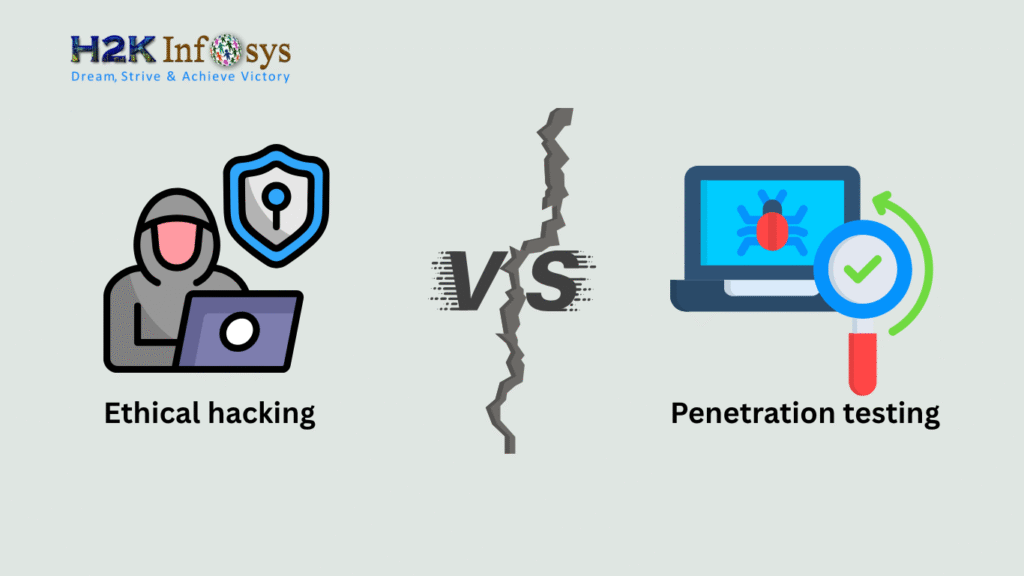The list of software testing types is vast. This is second list of 100 types of software testing. The software project scenarios are different, hence there is need of many scenario based testing types to be performed. Below is the list of software testing types that are performed in most of the software projects in common. The first list of software testing types can be viewed by clicking here.
List of Software Testing Types: 100 types of software testing – List 2
- Portability testing
- External interface testing or intersystem testing
- High availability testing
- Interoperability testing or compatibility testing
- Negative testing
- Happy path testing
- Grey box testing
- Key word driven testing
- Hybrid testing
- End to end testing
- Performance testing
- Load testing
- Volume testing
- Stress testing or Spike testing
- Soak testing or endurance testing
- Maintainability testing
- Monkey testing
- Random testing
- Mutation testing
- Penetration testing
- Usability testing
- Risk based testing
- Web services testing
- ETL testing
- Mobile testing
- Use case testing
- Back end testing
- Browser compatibility testing
- Cross browser testing
- Recovery testing
- Risk based testing
- Failover testing
- Scalability testing
- Compatibility testing
- Operational testing
- Pair testing
- Equivalence partition testing
- Boundary value testing
- Mainframe testing
- SAP testing
- JUnit testing
- unix/linux testing
- Security testing
- Reliability testing
- Robustness testing
- Retesting
- Regression testing
- Fuzzy testing
- GUI Testing
- Heuristic testing
The software testing type to be performed is decided by test leader and specified in the software test plan. The different software testing type can be assigned to the different software testers in the software testing team. The software testing can be either manual or automation testing.
Check your understanding:
- List FIVE more different software testing types NOT mentioned in the above list
- Pick any TWO types of testing from the above list of software testing types and describe in two sentences





















85 Responses
Beta testing
Age testing
APL testing
All pairs testing
Basis Path testing
Compatibility Testing: Testing technique that validates how well a software performs in a particular hardware/software/operating system/network environment. It is performed by the testing teams.
Fuzz Testing: Software testing technique that provides invalid, unexpected, or random data to the inputs of a program – a special area of mutation testing. Fuzz testing is performed by testing teams.
Ans.: The five more different software testing types NOT mentioned in the above list are:
• Sanity Testing
• Black Box Testing
• White Box Testing.
• User Acceptance Testing (UAT)
• Selenium Testing
Ans.: The description of two different types of testing from the above list of software testing :
– Monkey Testing: It is done with no specific test in mind. Here the monkey is the producer of any input data (which can be either a file data or can be an input device data). It involves pressing some keys randomly and checking whether the software fails or not
– Cross Browser testing: It test compatibility of the software with different browser of different versions using cross browser testing tools. Example: fire fox, chrome etc
1)Smoke testing
2)Functional testing
3)Sanity testing
4)Retesting
5)Regression testing
A) Smoke testing:- Test the initial steps of each functionality. For eg: login page, links & button, pages, fund transfer link- page,..etc.
B) Retesting:- Test if the defects are fixed.
C) Regression Testing:- Test if new defects are introduced into software due to changes in software & its environment.
1) White box testing
2)Black box testing
3)Experience based testing
4)Functional testing
5)Retesting
Description of two different types of testing from the above list of software testing -:
1) White box testing -: This type of testing is done at program level.Its done by deveolers.
2)Black box testing -:Black box testing is done during the system testing by software testers. The specifications of the software requirements are used to prepare the test documents.
1. smoke testing, static testing, dynamic testing, white box testing, black box testing.
2. Grey box testing: It is a combination of white-box testing and black-box testing. The aim of this testing is to search for the defects if any due to improper structure or improper usage of applications.
Back end testing: It is nothing but server side or Database Testing. The data entered in the front end will be stored in the back-end database.
Functional testing
Non functional testing
smoke testing
sanity testing
manual testing
Browser compatability testing : test compatability of the software with specific browser
External interface testing: test interface between two independent softwares
Volume testing:
In the volume testing, the performance testing is done with different volumes of data to identify the maximum volume of data supported by the software. For example: the bank database is loaded with huge volume of customer data, that affects the efficiency of the system.
Static Testing:
Software testing is done throughout the software development life cycle which can reduce the future defects, hence reduce time and cost of the project. Static testing is one such effective way, wherein, the project documents are reviewed to identify the errors
1. Functional Testing.
2. Black Box testing.
3.White Box Testing.
4.Unit / Integration Testing.
5.Smoke Testing.
–> Recovery Testing: In software testing, recovery testing is the activity of testing how well an application is able to recover
from crashes, hardware failures and other similar problems.
–>End To End Testing: End-to-end testing is a methodology used to test whether the flow of an application is performing as
designed from start to finish.
Different Types of software Testing :
1.) Vulnerability Testing
2.) Install/Uninstall Testing
3.) Component Testing
4.) Basis path Testing
5.) Globalization Testing
High Availability Test : Testing the availability of back up server when actual server fails .
Browser Compatibility Test : Testing the compatibility of the software with specific Browser .
1) All pairs testing
2) Agile testing
3) Branch Testing
4)Sanity testing
5). Functional Testing.
A)Browser compatibility testing : Test compatibility of the software with specific browser.
B)External interface testing: Test interface between two independent software.
FIVE more different software testing types not mentioned in the above list are:
Alpha Testing
Static Testing
Beta Testing
Smoke Testing
User Acceptance Testing
Load Testing:
Load testing is the process of putting simulated demand on software in a way that tests or demonstrates it’s behavior under various conditions.Testers can measure response times, throughput rates, and resource-utilization levels, and to identify application’s breaking point through load testing.
Volume Testing:
Volume testing is done to analyze the software performance by increasing the volume of data in the database.
With the help of Volume testing, the impact on response time and software behavior can be studied when exposed to a high volume of data.
Functional Testing
Database Testing
Smoke Testing
Selenium Testing
Performance Testing
Security Testing-is to validate the system that does not allow to access data w/o proper authentication.
Regression Testing-tests if new defects are introduced into software due to changes in software and its environment.
1. Alpha Testing
2. Integration Testing
3. Back End Testing
4. Comparison Testing
5. Beta Testing
Cross Browser Testing-This technique allows the testers to see how well the software reacts to different browsers. Have multiple browsers available for the system should eliminate system crashes.
High Availability testing- Ensures that a backup server is available when the current server fails. A back up server should readily be available at all times to ensure the client can still access their system even after the first server crashes.
1. Alpha testing
2. Beta testing
3. Smoke testing
4. Functional testing
5. Sanity testing
A. Regression testing: Checking whether all the closed bugs are still closed and no part of the system is broken after the fix.
B. Load testing: Testing to see how much load the software can bear at a time .Meaning checking how many users at a time can use the system without making it to slowdown or crash.
. 5 types of testing
functional testing
Analytical testing
Beta testing
Black box testing or specification based testing
agile testing
beta testing: – beta testing is also referred
as user acceptance testing(UAT)or end user testing to as user acceptance testing(UAT) or end user testing.
smoke testing:- its a build verification testing. Used to decide if a build is stable enough to proceed with further testing.
.
1)Smoke testing
2)Functional testing
3)Sanity testing
4)Retesting
5)Regression testing
A) Smoke testing:- Test the initial steps of each functionality. For eg: login page, links & button, pages, fund transfer link- page,..etc.
B) Retesting:- Test if the defects are fixed.
C) Regression Testing:- Test if new defects are introduced into software due to changes in software & its environmen
1. Ans: a. API and WEB services testing
b. Keyword or script-based testing
c. Collaborating testing
d. Code driven testing
e. Active testing.
2.Ans: Web testing: Web testing is the medium of communication through which two applications / machines will exchange the data irrespective of their underline architecture and the technology.
Security testing: Security testing is a testing technique to determine if an information system protects data and maintains functionality as intended. It also aims to verify the confidentiality, integrity, authentication, authorization, avaibility and non-repudiation.
1. API testing
2. Beta testing
3. Fault testing
4. Error guessing
5. Big bang testing
A. Security testing – is a type of testing that tries to uncover bugs or vulnerabilities of the system. It usually checks the weakness through Operating systems or database and other systems.
B. Fuzzy testing – this a type of security testing where they used massive amounts of data called fuzz to try to break the system and try to make it less vulnerable or rather a secured system.
Alpha Testing
Beta Testing
Black Box Testing
functional Testing
Non Functional Testing
Load Testing:Test the performance of the software with different number of users and identify the maximum number of users support by the software.
Volume Testing:Test the performance of the software with different volumes of the data and identify the maximum volume of the data supported by the software.
1. Acceptance testing
2. Black box testing
3. White box testing
4. Functional testing
5. Agile testing
6. Big Bang testing
Retesting: After fixing the defects, retesting is done to check whether defects are fixed properly or not.
Load testing: This testing is done to identify how many users can use the software at the same time to check the performance of software in terms of speed.
1. Beta testing
Blackbox testing
Bottom-up Testing
Smoke testing
Sanity testing
2.Load Testing: Load Testing of software is done to identify the max no of users and to identify the max no users are supported by the software.
Volume Testing: Volume testing of software is done to identify the max volume of data and to identify the max volume of data are supported by the software.
Smoke testing
Functional testing
Sanity testing
Alpha testing
Beta testing
Smoke testing – Basic fuctionalities are tested briefly
Functional Testing – All functionalities are tested in detail with different sets of data
1. 5 other testing types
– Install testing
– Localization testing
– Gorilla testing
– All pairs testing
– Backward Compatibility testing
2. Stress testing or Spike testing: test performance of the software with different number of resources and identify the number of resources required by the software.
Soak testing or Endurance testing: test performance of the software under continuous usage.
White Box testing: done at program level. It is structure based and derived from the structure of the software.
black box testing: done at system level. The behavior of the system is tested.
experience based testing
regression testing
agile testing
1.white box testing
2.blackbox testing
3.alpha testing
4.beta testing
5.Static testing
Stress testing-test performance of the software with different number of resources and identify the number os resources required by the software.
Soak testing- test performance of the software under continuous usage.
1.functional testing
2.static testing
3.smoke testing
4.ad-hoc testing
5.acceptance testing
Retesting:- Test if the defects are fixed.
Regression Testing:- Test if new defects are introduced into software due to changes in software & its environment.
The five software testing types are:
1.Initial level testing:smoke testing
2.Exploratory testing
3.Sanity Testing
4.Functional Testing
5.IntegarationTesting
1.Performance Testing:It means speed and efficiency of the software.Factors affect speed are number of users,data,resources,usage etc.
2.Load Testing:Test the performance of the software with different number of users and identify the maximum number of users supported by the software.
Active Testing, Assertion Testing, Breadth Testing, Dependency Testing, Passive Testing, Stress Testing etc
Monkey testing: In this type of testing some random tests are executed with some random data with the aim of breaking the system. This testing helps us to discover some new bugs which might not be caught earlier.
Pair testing: In this type of testing two testers work together on one module. They basically divide the testing scenarios between them. The aim of this type of testing is to come up with maximum testing scenarios so that the entire module should have complete test coverage. Post testing, they can also document their test scenarios and observations.
1. List FIVE more different software testing types NOT mentioned in the above list
• Adaptability testing
• Agile testing
• Alpha testing
• Analytical testing
• API testing
2. Pick any TWO types of testing from the above list of software testing types and describe in two sentences.
Retesting- is running the previously failed test cases again on the new software to verify whether the defects posted earlier are fixed or not.
Regression Testing- Test if new defects are introduced in to software due to changes in software and environment
Localization testing: check the localized version of a product for that particular culture or local setting.
Gorilla testing: is a technique in which testers, sometimes developers also join hands with testers to test a particular module thoroughly in all aspects
Unit testing
Integrate testing
System testing
Alfa Testing
Beta testing
Retesting: Once the Defects are fixed by Programmer. QA will retest to make sure that they are fixed.
Soak Testing: Testing the performance of Software under continuous usage.
Five different software testing types are
1. White box Testing
2. Black box Testing
3. Alpha Testing
4. Beta Testing
5. Unit Testing
Re Testing: It is a type of testing performed to check the test cases that were unsuccessful in the final execution are successfully pass after the defects are repaired.
Regression Testing: It is a type of software testing executed to check whether a code change has not unfavorably disturbed current features & functions of an application.
1. List FIVE more different software testing types NOT mentioned in the above list
white box testing
black box testing
smoke testing
sanity testing
uat testing
Pick any TWO types of testing from the above list of software testing types and describe in two sentences
load testing: to test the speed of the software with different number of users
soak testing:test the software with continuous usage.
List FIVE more different software testing types NOT mentioned in the above list
Sanity Testing
Smoke Testing
Adhoc Testing
Negative Testing
Functional Testing
Pick any TWO types of testing from the above list of software testing types and describe in two sentences
Penetration Testing – It is Testing the potential security breaches of the software before any hacker can do it. Also known as pen hacks, white hat attacks, ethical hacking. It is to find out the security weakness of the software. We can find out the hard coded values like username and password by doing this testing.
Portability Testing – Portability Testing is done to test the flexibility of the software to use on different system configurations and if it is movable from one system environment to another. It is measured in terms of effort taken to transfer from one system to another. The main purpose is to move the application across multiple environments and not just platforms. Example: the application developed should be compatible with google android, windows , Apple IOS operating system etc. Here , many hardwares configurations are required. Providing support and maintenance can become difficult, time consuming and can have budget issues.
Types of Portability testing- Adaptability Testing, comparability – co existence testing, installation ability testing, localization Testing, interoperability Testing, replaceability Testing.
penetration testing,usability testing,alpha testing,beta testing,uat,system testing
Volume testing-testing-In this type of testing the software is subjected to a huge volume of data and analyze the performance of the system,. For example, testing the music site behavior when there
are millions of user to download the song.
soak testing- Here we test the stability of the system over a long period of time under the continuous usage of the software. It handles issues related to memory allocation, log files and database resource utilisation
. Example Testing
2. Smoke testing
3. Sanity testing
4. branch testing
5. Interface testing
Example testing:
It means real-time testing. Example testing includes the real-time scenario, it also involves the scenarios based on the experience of the testers.
interface testing:
Interface Testing is performed to evaluate whether systems or components pass data and control correctly to one another. It is to verify if all the interactions between these modules are working properly and errors are handled properly.
List FIVE more different software testing types NOT mentioned in the above list:
Install testing, usability testing, volume testing, recovery testing and database testing.
Pick any TWO types of testing from the above list of software testing types and describe in two sentences,
End-to-end testing:
End to end testing is a major type of testing where entire software is tested from start to end,using the exact production like data and the test environments to simulate the real time settings. It confirms that the integrated components of the software, functions as expected.
Portability testing:
It is tests the flexibility of the software to be easily usable on different system configurations and movable from one system environment to other. It tests the adaptability,compatibility & co existence, installation ability,interoperability, localisation and replaceability of the software in different environments.
FIVE more different software testing types NOT mentioned in the above list are as follow :
1. Hybrid Integration Testing:
Testing technique which combines top-down and bottom-up integration techniques in order leverage benefits of these kind of testing.
2. Install/uninstall Testing:
Quality assurance work that focuses on what customers will need to do to install and set up the new software successfully. It may involve full, partial or upgrades install/uninstall processes.
3. Manual Scripted Testing:
Testing method in which the test cases are designed and reviewed by the team before executing it.
4. Upgrade Testing:
Testing technique that verifies if assets created with older versions can be used properly and that user’s learning is not challenged.
5. Workflow Testing:
Scripted end-to-end testing technique which duplicates specific workflows which are expected to be utilized by the end-user.
TWO types of testing from the above list of software testing types :
1. End-to-end Testing:
Like system testing, it involves testing of a complete application environment in a situation that mimics real-world use, such as interacting with a database, using network communications, or interacting with other hardware. It not only validates the software system under test but also checks its integration with external interfaces.
2. Fuzz Testing:
Fuzz Testing is a type of testing where automated or semi-automated testing techniques are used to discover coding errors and security loopholes in software, operating systems, or networks by inputting invalid or random data called FUZZ to the system. After which the system is monitored for various exceptions, such as crashing down of the system or failing built-in code, etc. It is a type of Security Testing.
1. Smoke Testing
Sanity testing
User Acceptance testing
White box Testing
Black box Testing
2.Stress Testing – During stress testing, the system is monitored when it id overloaded to ensure that the system can sustain the stress.
Soak Testing – During Soak testing the system’s reaction is monitored if it can withhold a huge load for a longer period of time.
Testing not mentioned above:
1. White Box Testing
2. Black Box Testing
3. Alpha Testing
4. Beta Testing
5. Functional Testing
Two testing from above:
Cross browser testing: It is performed by testing the compatibility of the software with different browser like chrome, firefox, IE, safari etc.
Security Testing: In this testing security feature of a software is tested like logged out if idle, block account for repeated incorrect password etc.
1. Agile testing
2. Big bang testing
3. Bottom up testing
4. Application based testing
5. Functional Testing
Load testing:- test performance of the software with the different number of users
and identify the maximum users supported by the software.
Volume testing:- test performance of the software with the different number of
volume of data and identify the maximum data supported by the
software.
5 different types: Accesibility testing, Ad hoc testing, adaptability testing, functional testing, Decision testing.
Big bang testing: All modules of software are integrated simultaneously which creates a big collection of modules & and all the modules are tested together. In this type of testing, the modules are not tested individually. In this type of testing, modules are not tested alone.
Error guessing: This is a test method where test cases used to find bugs in programs are established based on experience in prior testing. This is an experience based technique where the test analyst uses their experience to “guess” the problematic areas of the application.
(I mixed up Set 1 and Set 2 answers)
Smoke Testing
Sanity Testing
Regression testing
white box testing
manual testing
some of the important testing terms explained below:
Load testing: ensure that the system can handle expected amount of load in peak conditions
Stress testing: test the actual point where the system breaks down.
1) Some more software testing types not mentioned in the above article are: Smoke testing, sanity testing, control flow testing, efficiency testing, database testing.
2) GUI testing – GUI testing is defined as the process of testing the system’s Graphical User Interface or basically what the user sees. GUI testing involves checking the screens with the controls like menus, buttons, icons, and all types of bars – toolbar, menu bar, dialog boxes, and windows, etc.
Robustness testing – It is the way to assess the quality of a software product. It is the process of verifying whether a software system performs well under stress conditions or not. It is carried out using a combination of valid and invalid inputs that is passed to the system and checked for the performance.
FIVE more different software testing types not mentioned in the above list are:
Alpha Testing
Static Testing
Beta Testing
Smoke Testing
User Acceptance Testing
Load Testing:
Load testing is the process of putting simulated demand on software in a way that tests or demonstrates it’s behavior under various conditions.Testers can measure response times, throughput rates, and resource-utilization levels, and to identify application’s breaking point through load testing.
Volume Testing:
Volume testing is done to analyze the software performance by increasing the volume of data in the database.
With the help of Volume testing, the impact on response time and software behavior can be studied when exposed to a high volume of data.
1)
a)Alpha testing
b)Beta testing
c)Dynamic testing
d)Experience Based testing
e)Regression testing
2)User Acceptance Testing: It is also called as Black Box Testing. This test is to make sure the software is behaving as per the expectation of the client.Programs are not involved in this testing,web applications are tested.
Load Testing: Test the performance of software with different number of users and identify the maximum number of users supported by software.
Benchmark Testing, Breadth Testing, Code-driven Testing, Configuration Testing, Domain Testing.
Penetration Testing: this is a type of test where a virus is purposely meant to attack a system to see if the software is performing as it should.
Performance Testing: This is to ensure the software is functioning properly.
1. List FIVE more different software testing types NOT mentioned in the above list
white box testing
black box testing
smoke testing
sanity testing
uat testing
Pick any TWO types of testing from the above list of software testing types and describe in two sentences
load testing: to test the speed of the software with different number of users
soak testing:test the software with continuous usage.
1.List FIVE more different software testing types NOT mentioned in the above list:
Alpha Testing,Beta testing,smoke testing,UAT testing,.static testing
2.Pick any TWO types of testing from the above list of software testing types and describe in two sentences
1.Performance Testing: It means speed and efficiency of the software.Factors affect speed are number of users,data,resources,usage etc.
2.Load Testing :Test the performance of the software with different number of users and identify the maximum number of users supported by the software
The five more different types of testing:
1. Smoke testing
2. Decision testing
3. Agile Testing
4. White Box testing
5. Black Box testing
GUI testing: It is the process of testing a product’s graphical user interface of Application Under Test to ensure in meets its specifications. It is normally done through the use of variety of test cases.
ETL testing: ETL stands for Extract-Transform-Load. It is done to ensure that the data that has been loaded from a source to the destination after business transformation is accurate. It also involves the verification of data at various middle stages that are being used between source and destination .
Five software testings are:
1.Boundary Value testing
2.Branch testing
3.comparison testing
4.Example testing
5.Gorilla testing
explanation of two software tesing:
1) Equivalence partition testing: the aim of this testing is to remove redundant test cases within a specific group which generates the same output but not any defect.
2)GUI testing : The objective of this Graphical User Interface testing is to validate the GUI as per the business requirement. It includes the size of the buttons and input field present on the screen, alignment of all text, tables and content in the tables.
LIST OF SOFTWARE TESTING TYPES
Performance testing
Load testing
Volume testing
Stress testing or Spike testing
Soak testing
Browser compatibility testing
Retesting
Regression testing
Five software testing types:
Interface testing,
User acceptance testing,
Documentation testing,
Installation testing,
Exploratory testing.
Load testing:- test performance of the software with the different number of users
and identify the maximum users supported by the software.
Volume testing:- test performance of the software with the different number of
volume of data and identify the maximum data supported by the
software.
1.Alpha testing
2.Analytical testing
3.API testing
4.Beta testing
5.Big bang testing
Browser Compatibility testing: Test the compatibility of the software with the specific browser. Ex: Internet explorer, Safari, Firefox.
Cross Browser Testing: Test the compatibility of the software with the different version of the same browser. Ex : Internet Explorer with different version
1.Testing types are
alpha testing
beta testing
smoke testing
sanity testing
system testing
2. Stress Testing: is done with different number of resources.
soak testing: is done under continuous usage of software.
Alpha Testing
Beta Testing
Back End Testing
Integration Testing
Comparison Testing
Security Testing – Checking the security features of the software .
Browser Compatibility Testing – Testing if the software is compatible with different types of browsers like chrome , edge , safari.
Functional testing.
Non-functional testing.
Gorilla testing.
Incremental integration testing.
Static testing.
Happy path testing: It is done to test an application successfully on a positive flow. It does not look for eeror conditions.
Negative testing: It is done using incorrect data or input. It validates that if the system throws an error of invalid input and behaves as expected.
alpha testing
beta testing
smoke testing
sanity testing
system testing
GUI Testing: is a software testing type that checks the Graphical User Interface of the Software
Boundary testing: is the process of testing between extreme ends or boundaries between partitions of the input values
White box testing
Black box testing
Alpha testing
Beta testing
Automation testing
Soak testing takes the system to its limits over a sustained period of use. In other words, soak testing allows the team to mimic the real world usage, in which the users will constantly need access to the system.
Stress testing is performed to test the robustness of the software application under extreme load. Buffer overflows are classic examples of stress test results.
)Five different software testing types not mentioned above are:-
Alpha testing
Beta testing
Functional testing
Manual testing
Automation testing
2)Regression Testing:- This type of testing is done to test if new defects are introduced into software due to changes in software and its environment.
Cross Browser testing:- This type of testing is used to test the compatibility of the software with different browsers of different versions using cross browser testing tools.
Like · Reply · 2d
Smoke Testing
Sanity Testing,
Manual Testing,
Automation
Happy Path Testing – is when the expected outcome is delivered when the testers enter known inputs.
Mobile Testing – is when mobile apps are testers for functionalities.
List of software testing types
White box testing
Black box testing
Static testing
Dynamic testing
Unit testing
Static testing: This is the first stage of the software testing. Review of the project documents at the initial level of the testing.
Black box testing: This testing is done by the developers or programmers on development stage of the software.
FIVE more different software testing types are Functional Testing, Exploratory Testing, Static Testing, Dynamic Testing, Sanity Testing.
Retesting: Test done to see if defects are fixed after Sanity test (Sanity Test – Test initial step of each functionality in which defects are fixed).
Regression Testing: Test if new defects are introduced in the software due to changes in the software and its environment.
Very useful information…Keep sharing such informative post, I Would love to read more about your other post
Assignment No: 6
1. List FIVE more different software testing types NOT mentioned in the above list.
a) Integration Testing
b) Alpha Testing
c) Beta Testing
d) Build acceptance testing
e) Functional Testing
2. Pick any TWO types of testing from the above list of software testing types and describe in two sentences.
a) Integration Testing : – This testing is done to integrate two modules together. This kind of testing is done after unit testing.
b) Functional Testing : – This kind of testing to check the functionality of each function. For example : Gmail Username functionality and Password functionality.
a. List FIVE more different software testing types NOT mentioned in the above list.
1. Alpha testing
2. User acceptance testing
3. Database testing
4. Integration testing
5. Static testing
b. Pick any TWO types of testing from the above list of software testing types and describe in two sentences.
1. Cross Browser testing : It is a type of non-functional testing that checks whether the application works as required when
execute using different Browser-OS combinations. Widely used browsers are Firefox, Chrome, Edge and Safari. Mostly used operating systems are Windows, macOS , iOS and Android.
2. Security testing : It is a process to find the flaws in the security mechanisms of a s/w or application that protect data and maintain functionality as expected.
1.Database testing
2.Comparison testing
3.Basis Path Testing
4.Static testing
5.Alpha testing
1.Retesting-When a bug is fixed by the developer, testing the same bug to ensure whether it has been fixed or not is known as retesting.
Regression testing-Testing the other features of the application which might be affected by the bug fix is known as regression testing.
1.List FIVE more different software testing types NOT mentioned in the above list
1. Blue box testing
2.Exploratory testing
3.Adhoc testing
4.Alpha testing
5. Beta testing
2.Pick any TWO types of testing from the above list of software testing types and describe in two sentences
Grey box testing: testing a software with partial knowledge about the internal working of the Application is called Grey box testing.
GUI : Graphical interface testing is the type of testing the funtions of an application that are visible to the user like textboxes, buttons, links and other list boxes are working and satisfies user requirement .
Unit/Component testing, Integration testing, Security testing, Alpha testing, Beta testing
Load testing: The performance of the software is tested with multiple number of users accessing the software at the same time.
Volume testing: The performance of the software is tested with large volume of data
1.
– Black Box Testing
– White Box Testing.
– User Acceptance Testing (UAT)
-Alpha testing
– Beta testing
2.
– GUI testing is the process of ensuring proper functionality of the graphical user interface (GUI ) for a given application and making sure it conforms to its written specifications. GUI testing evaluates design elements such as layout, colors, fonts, font sizes, labels, text boxes, text formatting, captions, buttons, lists, icons, links and content.
– Regression testing is a software testing practice that ensures an application still functions as expected after any code changes, updates, or improvements. Regression testing is responsible for the overall stability and functionality of the existing features.
1. List FIVE more different software testing types NOT mentioned in the above list
Positive Testing
Database Testing
Localization Testing
Alpha Testing
Dynamic Testing
2. Pick any TWO types of testing from the above list of software testing types and describe in two sentences
Security Testing: Security testing is an integral part of software testing, which is used to discover the weaknesses, risks, or threats in the software application and also help us to stop the nasty attack from the outsiders and make sure the security of our software applications.
Regression Testing is the process of testing the modified parts of the code and the parts that might get affected due to the modifications to ensure that no new errors have been introduced in the software after the modifications have been made. Regression means return of something and in the software field, it refers to the return of a bug.